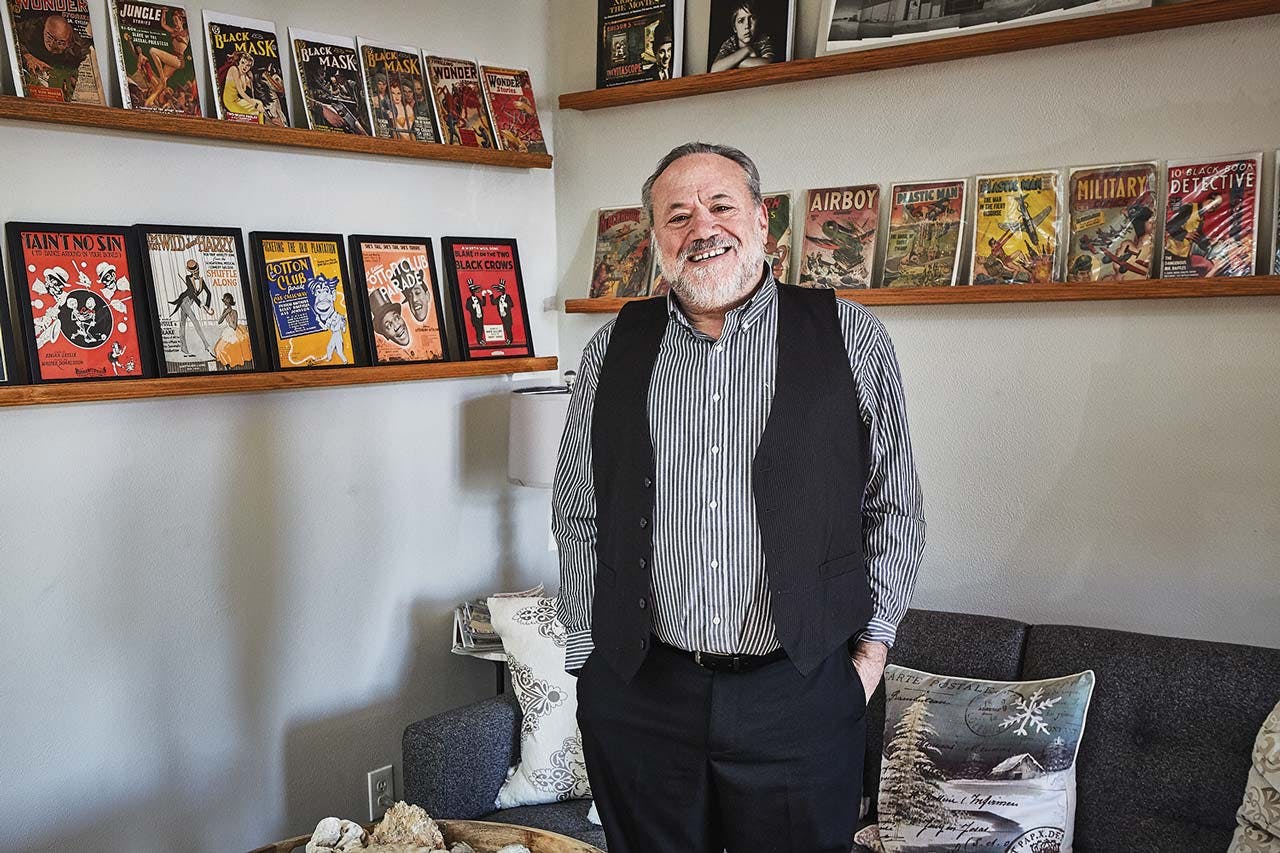
After I graduated from the University of Texas, in 1979, I lived in a series of large, cheap, drafty houses in West Campus, always with three or four roommates. I was a slacker. I waited tables and clerked in a record store, working as few hours as possible. What I really wanted to do was write songs and play the guitar. One day I was banging around in my living room with the windows open when I heard a knock on the door. It was a friendly young guy with blond hair. “Who do you play with?” he asked. I thought he was joking. “No one,” I replied. “Maybe we could get together and jam,” he suggested.
In a month Phillip McCarthy and I had a rhythm section and a name, the Soul Bashers, and we were playing at parties and even a few clubs. There were a lot of bands like us, combos of intent twentysomethings knocking out soul or punk songs at co-ops and in living rooms. The bar was low. You didn’t have to be a great musician; you just had to love music. The possibilities seemed endless—we were all making something new, even when we were just covering Otis Redding.
Back then Austin was a college town, known by the outside world, if at all, as the home of a sometimes successful football team. The city had no industry, no famous people aside from Willie Nelson, and maybe two nice restaurants. It took only fifteen minutes to get anywhere, even the Village Theater way up north on Anderson Lane. At night downtown was dead, except for Sixth Street, which was overrun by preppies and drunks. South Congress Avenue was a seedy stretch of crumbling motels, drug dealers, and working girls. We sneaked into Barton Springs whenever possible, wore cutoffs and flip-flops, smoked a lot of pot, and mourned the closing of the Armadillo World Headquarters, in 1980, as if it were the end of Eden.
Thirty-six years later, I still play in a band. Not the Soul Bashers, which never made it past 1982, but the Wild Seeds, which I started a couple of years later. We had a nice career, making albums and touring, until we broke up, in 1989. The band reunited a few years ago to play a tribute show, and because it was so much fun, we kept going. In November I visited our bass player, Marcus Piña, at his office. Marcus moved here from Seattle in 2009, and he had recently taken a job as a senior creative director at a company called Under Armour Connected Fitness. “Hmm,” I’d thought, when he told me. “You’re working for a T-shirt company.”
Not exactly. In fact, the only T-shirts I saw when I walked into Under Armour’s downtown “digital headquarters” were on the young people working there, software engineers and designers analyzing data on computer screens. They were trying to perfect, through apps and tiny sensors, the measure of what techies call the quantified self: things like calories burned, steps taken, and hours slept. The quantified self is a modern tech movement seeking self-knowledge through data. Know thyself through thy gadgets.
Marcus walked me through cavernous spaces with ultramodern light fixtures hanging from tall ceilings. “It’s set up like a studio,” he said, “and that leads to collaboration.” Employees sit together, brainstorming about the stylish black UA wristband that measures your heart rate or the data-collecting chip that fits in the UA SpeedForm Gemini 2 smart running shoe. Sometimes they walk over to the spin boardroom, where they suss out changes while pedaling on red-orange stationary bikes. They take the smart shoes or wireless headphones for a test run a block away on the hike-and-bike trail along Lady Bird Lake. Marcus showed me the treadmill desks, the video arcade, and a giant workout room where employees take part in yoga classes and fitness boot camps. Finally we got to the kitchen, which has a latte machine, a cold-brew coffee tap, and a counter laid out with fruit. A young man grabbed a banana and headed back to his desk.
Welcome to the New Austin, I thought, a world of data, design, and modern movements I am not a part of. And youth. Last year Under Armour Connected Fitness hired almost one hundred people, and like most others in Austin’s exploding tech scene, they’re young and from somewhere else. Many live in the new downtown condo towers built over the past decade. They shop at nearby Whole Foods Market or Trader Joe’s, hang out after work at Lamberts or the Tiniest Bar in Texas. It’s a creative class very different from the one I knew in my mid-twenties. These kids are not slackers by any stretch of the imagination. They have good jobs, and they’ve turned downtown into a completely new place, one that barely sleeps.
Somewhere in the haze of the last generation, funky Old Austin disappeared and was replaced by something sleek, fast, and unbelievably popular. Suddenly everyone wants to be in Austin, from tech twentysomethings to middle-aged corporate hot shots. Austin is the fastest-growing big city in the country, at the top of lists for things that can be measured (real estate and jobs) and things that can’t (cool and kicks). It has become the City of the Eternal Festival, from South by Southwest and the Austin City Limits Music Festival to Pachanga, Reggae, and Formula 1. Where else can you eat the best barbecue in the world, watch more than a million hungry bats ascend into the gloaming above the Ann W. Richards Congress Avenue Bridge, hear amazing music every night of the week, and behold Lady Gaga covered in vomit as part of a SXSW show? Two months ago Forbes called Austin the next boomtown, apparently forgetting that Bloomberg ranked us the country’s number one boomtown back in 2013. As of October, the greater metropolitan area had grown to an astonishing 2 million people, which is 1.4 million more than we had in 1980, when I was slacking my life away.
A lot of cities are growing fast, especially in Texas. But Austin is reinventing itself in a manner unlike any other place. In many ways the transformation has been painful. I don’t recognize some parts of my city anymore, like the East Side, where longtime black and Hispanic residents have been pushed out because they can’t afford to live there. I have friends of my ilk—writers and musicians—who have had to move to places like Smithville and San Antonio because they can’t afford it here either. Traffic is the worst in the state. Every time I get on I-35 and slow to a crawl, I curse this place and all the people who just moved here. I wonder: How the hell did Austin go from slacker village to crazed boomtown? Was it worth it? And what will the city be like when the next million people get here?


The story of Austin is a complicated one, its cast of characters full of outsiders, pot smokers, and extremely passionate citizens. Most of them came here for the same reason I did: UT. When I arrived from San Antonio, I learned about the city’s recent history, like the student demonstrations and marches on the Capitol in the sixties for civil rights and against the Vietnam War, plus all the creative weirdos who’d gone to school then, such as cartoonists Gilbert Shelton and Jack Jackson and musicians like Janis Joplin. Roky Erickson had pioneered the unbelievably strange psychedelic rock scene, and Austin’s reputation as a place for liberals and iconoclasts had been solidified when Willie moved here, in 1972, bringing together hippies and rednecks at the Armadillo and playing the first episode of Austin City Limits, a TV show that offered up the state’s heterodox music scene to the rest of the world. Willie loved Austin—it was different from the rest of Texas, a beautiful, idyllic garden.
Austin’s natural beauty is, in fact, what gave the town its very existence. In 1839 President Mirabeau Lamar sent a scouting party to find an appropriate place for a capital of the new Republic of Texas, and they rode upon a tiny riverside community surrounded by rolling green hills, pale limestone cliffs, sprawling live oaks, and clear bubbling springs. The town, first called Waterloo, was renamed Austin, and in 1853 the new government constructed a capitol building, followed in 1883 by UT. In 1940 city leaders successfully dammed the Colorado River, and when five other dams were built to the west, we had the prettiest chain of lakes in Texas. By my senior year, my friends and I were heading out to Lake Travis as often as possible, to the flat rocks past Mansfield Dam, where we drank beer and stared at the water, dreaming up lyrics and singing songs.
By then I had become part of a tradition that went back a generation: find others in your tribe and do cool stuff. Austin was full of people like us, who stuck around because it was cheap and they could draw pictures, make movies, write science fiction, play guitar. In 1981 UT grads Louis Black and Nick Barbaro started the Austin Chronicle, an alternative weekly, and my friend Chris Hearne, whom I had worked with at a bookstore on the Drag, founded Third Coast magazine. My pals Paul Cullum and Brian Hansen released a brilliant short movie called Speed of Light. A guy I worked with at the Capitol, Steve Utley, wrote a series of comic books based on his characters the Huggybunnies.
These creative types helped make Austin what it is today, in their own stubborn fashion. “Austin people are self-consciously casual about what’s important in life,” says downtown developer Perry Lorenz, a UT grad who bartended at the legendary hippie bar Soap Creek Saloon in 1973 and appeared in the 1974 horror flick The Texas Chainsaw Massacre (he rescued the lone survivor, driving her away in a pickup). Today he wears jeans to million-dollar closings: “You go to Dallas and it’s completely different.”
Lorenz is one of the fathers of the New Austin, a developer who has had a hand in erecting eight high-rises and is one of the partners in the Independent, the 58-story cantilevered “Jenga tower” that broke ground in January and will be the tallest residential building west of the Mississippi River. He’s like the city’s other fathers and mothers: dropouts, iconoclasts, weirdos. Some are famous, like Willie, Michael Dell, state senator Kirk Watson. Others less so, like Chronicle editor Black, hotelier Liz Lambert, SXSW co-founder Roland Swenson, environmental activist Mary Arnold. They’re smart and intense, and they came of age in a city that encouraged them to take chances. So they did.
Arnold, who’s eighty, helped turn Austin into a city that aggressively protects its natural beauty. The UT grad was a mother and a housewife in the early seventies when, inspired by a friend, she got involved with a group trying to save a golf course, Lions Municipal, from being sold to developers. The Save Muny campaign won, and she then joined her neighborhood association and We Care Austin, a women’s environmental group. At the time, Austin was locked in a brutal war between the business community and citizens alarmed at the city’s rapid growth, who formed more than 150 neighborhood groups. The war got more intense when swimmers at Barton Springs complained about the pool’s cloudy water, which they blamed on development over the watershed. Tensions escalated further in the late eighties, when Freeport-McMoRan, a multinational corporation, announced plans to build a four-thousand-acre development in the same area. Arnold’s group banded with other activists and raised a ruckus that culminated in an all-night city council meeting in June 1990, when she and 150 others spoke passionately about why the city shouldn’t allow the construction. “It was phenomenal,” she remembers. Unbelievably, they won, leading to the historic Save Our Springs ordinance, which offered unprecedented protection of the watershed. It also affirmed that Austin was unlike the rest of Texas; it was a place where housewives and hippies could come together and create something special.

If you had to point to one single thing that has driven Austin to be a hip boomtown, it would be South by Southwest, the music, film, and tech conference that got its start in the fevered mid-eighties music scene. Swenson was a UT student who became a band manager and was a staffer at the Chronicle. He was also part of a group of people working with the convention and visitors bureau to try to grow the local music scene. In 1986 the CVB underwrote a promotional package to hype Austin music, putting together a tape of a dozen Austin artists, including the Wild Seeds, and sending it to the New Music Seminar, a prominent conference in New York. NMS agreed to hold a version of the conference in Austin, but the plan stalled. “We should do it,” Swenson told his friend Louis Jay Meyers, who had also worked on the NMS promotion. They went to Black and Barbaro at the Chronicle for sponsorship help, then to the CVB, which gave them $5,000 in seed money. Then the four of them got together to plan their conference. It was all very do-it-yourself: Black, a film fan, came up with the name and Swenson the logo: SXSW.

That first year, 1987, they expected 150 registrants but got 700. The Wild Seeds couldn’t play SXSW; we were on tour that week in the Northeast. We didn’t play the next one either (Florida). We did a showcase at the third, in 1989, and it was one of my favorite Austin gigs ever. The club, a hard-rock joint called the Back Room, was packed, and fans were screaming. The night reached its crescendo when Richard Lloyd, from the band Television, joined us onstage. We sounded like pure rock-and-roll chaos, and I was certain we were going to get signed by a major label.
That didn’t happen. The band broke up soon after, but for the next few years, I played SXSW showcases with other groups (the Blue Dollar Hawks, the Lollygaggers, the Setters, the Brooders), sat on panels, and watched as the conference—which consistently booked a lot of local groups—began to overshadow the more established national festivals. The four guys who ran it were music fans first, but they also understood the big picture, for themselves and the musicians. “Music is an art and a business,” says Black, “and the more you know about the business, the more you have control of your craft.” In 1994 SXSW crossed over when Johnny Cash gave the keynote address, lending the conference credibility and purpose. Afterward he called SXSW “a great three-day thing of music and sharing—very stimulating to an artist and a songwriter to be in a place like Austin with what’s going on right now.” All of a sudden, even people outside the music industry knew about the quirky conference and its host city.
That year organizers also set up the Film and Media Conference, which split into two separate conferences in 1995. The film conference took off, because Austin already had a fledgling film industry anchored by Austin Film Society members Black and Richard Linklater. Linklater had moved to town from Houston after seeing a couple of Austin movies, including Speed of Light, and his 1991 film Slacker had immortalized what was then old, weird Austin. In 1997, just in time for the film conference, the newly opened Alamo Drafthouse, a theater started by Tim and Karrie League, screened its first movie, and by the following year there were 1,015 films entered at SXSW Film.
The media conference took longer to get going, partly because no one really knew what it was about (CD-ROMs? AOL?), and attendees were a mix of computer nerds and hackers. Organizers changed the name to Multimedia in 1995, and its director, Hugh Forrest, remembers asking Swenson, “Why are we doing this multimedia thing? We’ve got rock stars, film stars, and then some geeks.” Patience, Swenson counseled. In 1997 they changed its name to Interactive, because the Internet was changing everything.

Nowhere was this truer than Austin, where in 1997 Internet businesses—the dot-coms—were exploding. Michael Dell, who had started selling computers in his UT dorm room in 1984, had just begun selling them over the web to the tune of $2 million a day. Hundreds of others were trying to emulate him. Austin was becoming a tech capital.
This was not an accident; in fact, the groundwork had been laid back in 1957, when “high tech” meant Sputnik and UT conducted a study for the chamber of commerce that recommended that Austin recruit “light manufacturing.” The city had little else—no oil, natural resources, or high finance—so the chamber began trying to bring companies to Austin. In 1966 it scored: IBM, attracted by the city’s physical beauty as well as UT’s engineering department and its well-funded research programs, announced that it was buying four hundred acres in the northern suburbs and building a manufacturing plant that would eventually make the Selectric typewriter. Texas Instruments followed in 1969 and Motorola in 1974. The new companies located in the northwest part of town, along U.S. 183, which came to be known as Research Boulevard.
The chamber kept recruiting, and in the eighties scored again, landing huge deals with two big-time high-tech consortiums: Microelectronics and Computer Technology Corporation, in 1983, and Sematech, in 1988. Both chose Austin over dozens of other cities. By then, Dell was churning out PCs, and Origin Systems was making early computer games. The world was shifting, and in 1988 U.S. News & World Report called Austin Silicon Gulch.
Dell and Motorola, among others, expanded, and in 1995 a company called Trilogy, which had come to Austin from Silicon Valley, recruited nine hundred of the smartest software engineer graduates in the country. It was easy getting them to Austin. “Tech wants to grow around a creative culture,” says Jann Baskett, a founder of Austin design studio and creative agency Foxtrot Bravo Alpha. More and more new companies started up, some led by former Dell employees who had cashed out; venture capitalists invested millions in these dot-coms, some of which, like Garden.com and DrKoop.com, had done little in the real world. Mayor Kirk Watson offered millions of dollars in incentives to attract corporations such as Intel and Vignette, and Austin was flooded with new jobs, as more than three hundred companies moved here. The new people brought their cars, so traffic got exponentially worse, and they needed new homes, so the real estate market soared, especially in the suburbs and the rolling terrain of West Austin, which led to a new nickname: Silicon Hills.

The summer of 1999 was a sad one for me and my musician friends. In fact, we thought our world was ending, because our beloved Liberty Lunch was set to be torn down. The Lunch was a dump—no AC, cinder-block walls, splintered picnic tables, a partial roof—surrounded by empty lots and warehouses, like a lot of downtown. But it was our dump, a home to hundreds of local bands as well as a destination for national groups like Nirvana and Run-DMC. For a generation of us, the Lunch was Austin: shaggy, eclectic, wide-open.
I had an idea for an appropriate farewell: play Van Morrison’s “Gloria” for 24 hours. Going overboard with a three-chord anthem to the glory of sex and rejuvenation seemed a proper way to bid the Lunch goodbye, and I invited musicians to drop by and join my band the Brooders in making a spectacle of ourselves. We began playing those three chords at 9 p.m. on Friday, July 23. After an hour or so, other musicians started coming up and playing, then more, all paying homage. They arrived in shifts at all hours—punk drummers, pop singers, blues guitarists. It didn’t matter how many times the chorus came around, every time it was fresh, wild, and new. At 7 a.m. club manager Jeanette Ward served us beers, and an hour later I went home to take a nap. I drove back at 11:30, and as I made my way over the empty South First Street Bridge, I heard the three chords bouncing off the empty warehouses, like the city itself was singing “Gloria.” It was one of the most beautiful sounds I had ever heard.
At 9 that night we reached a crashing climax in front of a howling crowd. Later, owner Mark Pratz told a reporter about all the fans coming out to the club in its final days. “These people aren’t just mourning the loss of Liberty Lunch,” he said. “They’re mourning the loss of their town.”
In front of the club that night, patrons had burned a photo of Watson, the mayor who was allowing it all to happen. From the time Watson had been elected, in 1997, he’d talked of bringing environmentalists and developers together, which most Austinites thought was an impossible dream. But Watson had an idea: preserve land over the watershed and let developers have the moribund downtown. Watson called his idea the Smart Growth Initiative; he wanted downtown to become denser and more livable. “My plan was to grow out of the old economy and into the new economy, the creative economy,” he says. “I called it Austin 3D: the downtown digital district.”
Environmentalists and business groups alike supported a $712 million bond package to pay for smart growth and other city improvements, and the voters approved. Now new downtown residential and office developments would be mixed-use, their first floor home to shops and restaurants. The city developed a formula called the Smart Growth Criteria Matrix, which gave developers in the downtown area (including other parts of the city center, such as the East Side) fee waivers and tax abatements in exchange for using green building techniques or widening sidewalks and planting trees. “The smart growth matrix wasn’t so much for the incentives,” says Lorenz. “It got the city on your side.”
The city jump-started the downtown revitalization by beginning to develop six mostly empty blocks that it owned, including the land on which Liberty Lunch sat. Watson persuaded a company called CSC to build there instead of out in the hills, as well as sign a 99-year lease. Next would come the Second Street District, with a contemporary, spacious city hall, and the 85-acre Seaholm District, which would be a mini-village with housing, shops, and restaurants. Developers began planning condos and apartment complexes for the East Side.
Unfortunately, the national economy had begun to slow down, and by 2001, people were using the word “bust.” Many of those vaunted dot-com companies, like Garden.com and DrKoop.com, disappeared. Intel stopped building its new downtown headquarters, leaving an embarrassing concrete skeleton. Vignette pulled out of constructing a $350 million office complex near the shores of the lake. Firms began cutting workforces by as much as a third; Austin eventually lost more than 22,000 jobs. We all assumed the worst, that Austin would suffer the way it had in the eighties, after the savings and loan crisis, when we had the country’s highest rate of empty downtown office buildings. Even Texas Monthly made fun of Austin, noting “just how quickly and just how crazily everything went to hell.”

I’ve always thought that “Keep Austin Weird”—which began to show up on T-shirts and bumper stickers around the time of the bust—was a stupid slogan. Besides the fact that you can’t call yourself weird (that’s like calling yourself a poet or a genius—someone else has to do that for you), Austin wasn’t all that strange. To me, Austin was a city where you could do what you wanted. I wanted to make my own shirt: “Keep Austin Normal,” because normal in Austin has always been willfully doing your own thing. For years one of our most famous residents was Leslie Cochran, a homeless, bearded cross-dresser who cruised the streets wearing a thong and a tutu. Leslie, who died in 2012, wasn’t all that weird. He was just being Leslie.
For the past fifteen years, the whole “weird” thing has become a brand for Austin. The phrase was used as a battle cry for Waterloo Records and Book People in 2002, when the two local businesses—with the help of thousands of petitioners—fought the opening of a 25,000-square-foot Borders Books and Music at Sixth and Lamar. Borders ultimately backed out, and Whole Foods Market, one of the most iconic of Austin businesses, took its place.
Austin entrepreneurs aren’t exactly weird, they just march to their own beat—and become unimaginably successful. John Mackey, of Whole Foods, is one example. Another is Liz Lambert, who was an unhappy government lawyer sitting in the Continental Club on South Congress in 1995, mourning a friend who had just died of AIDS, when she had a revelation: “I’d rather do what I want to do than spend my life doing what I don’t want to do.” Across the street sat the crumbling Hotel San José, a seafoam-green motel that was home to prostitutes and derelicts. Lambert decided to fix it up and turn it into a hip, minimalist hotel. Soon she quit her job and devoted herself to the task. By 2002 her Hotel San José was often booked solid, and Jo’s Coffee, which she built in the parking lot next door, had lines down the sidewalk. By 2005 they had become the anchors of a renaissance along seedy South Congress, once the home of rough trade and now a strip of chic shops and restaurants. It even acquired a hipster nickname: SoCo.
Austin rebounded from the bust faster than other cities in Texas—partly because it had UT and state government but also because of businesses like Jo’s, Waterloo, and Book People and events like SXSW and ACL Fest, which began in 2002. The music scene was thriving, and so was the film scene, built around Linklater, Robert Rodriguez, and Mike Judge. Austin was a cool place to visit—and to live, where half your life could be spent outdoors and half the restaurants had patios and half of them had live music. It was still relatively cheap. Businesses from harder-hit cities relocated to Austin, bringing jobs. Start-ups began starting up again, many founded by former Dell or Trilogy people.
The downtown construction resumed: the 33-story Frost Bank tower opened in 2003, city hall was completed in 2004, and the tiny Rainey Street neighborhood, just south of downtown, was rezoned for high-density units in 2005. Condos and hipster bars and restaurants—Lustre Pearl, Clive Bar—followed. New mixed-use developments started going up along South Lamar Boulevard and Burnet Road; at the Domain, in far north Austin; and the Triangle, just north of UT. In 2007 a 711-acre “planned environment” began growing at the site of the old Mueller airport, a project built by a private company with money from the city, designed with pedestrian-friendly spaces, solar panels, and affordable housing units. And Austin started developing a food scene, with entrepreneurs opening creative restaurants, either in trailers, as was the case with Paul Qui’s East Side King and Aaron Franklin’s Franklin Barbecue, or in brick-and-mortar establishments, such as Bryce Gilmore’s Barley Swine and Larry McGuire’s Perla’s.
But there was a cost. The East Side changed drastically, with new development replacing longtime residences and businesses. The black population within the city limits dropped 5.4 percent in the aughts, and Austin was the only major U.S. city where that happened. Ora Houston, a city council member who’s lived on the East Side for more than sixty years, remembers going to a public forum in the late nineties and speaking against the whole idea of smart growth. “I said, ‘Nobody asked us if we wanted to be part of the Desired Development Zone.’ ” Of course, as soon as a city buys into the idea of downtown density, it can’t buy out. The effects are inevitable: the new people with money will drive away the old people without.
It was, fittingly, a start-up that helped make Austin what it is today: Twitter, which came to SXSW in 2007. It had officially launched a few months earlier, but at SXSW the company unleashed a full-scale marketing blitz, setting up flat-screen TVs all over the convention center and signing up attendees. Soon they were tweeting about things like where to go for dinner, and before long, everyone was checking their smartphones to see what everyone else was doing. It was the beginning of a new age, and both the city and SXSW would never be the same. The next year the conference saw a huge jump in registrants, from venture capitalists to people involved in things like start-ups and apps: the culture of the new. SXSW wasn’t just reflecting the world, it was changing it. Every March the city was becoming the place to be for anyone doing anything cool and creative. But it was also the place for college kids on spring break who wanted to have a good time. Celebrities started coming—to perform (Justin Timberlake) or to hype start-ups they’d invested in (Leonardo DiCaprio)—and so did giant companies like Google, Doritos, and Nokia, which took over downtown parking lots or entire streets and set up lavish unofficial shows and marketing “experiences,” like a 62-foot-tall vending-machine stage.
Austin was changing so fast I couldn’t keep up with it. Between 2008 and 2011, three towering condos opened—the 360 (44 stories), Spring (43), and the Austonian (56)—as well as the massive W Hotel and the state-of-the-art Moody Theater. The city’s high-tech world was accelerating too. In 2010 Facebook opened an office, and Samsung began expanding its facility to a mammoth 2.3 million square feet. In 2012 Apple began buying land and adding to its campus as well. That year venture capitalists invested more than $620 million in local start-ups. In 2013 President Obama visited Austin, famously saying, “The tech sector now drives more than one quarter of Austin’s economy—and all of this has helped make Austin one of the fastest-growing cities in America.”
This year, which marks the fiftieth anniversary of the arrival of IBM, tech drives Austin like nothing else. There are more than 5,000 local tech companies in Austin employing more than 120,000 people. They make chips and computers but also software, mobile apps, games, and wearables. They collect and store data, create visual effects for movies, and develop new social media platforms. There are nearly 200 “life science” companies that develop software for education, biotech, and health tech. The hardware and manufacturing companies are mostly in the suburbs; the software companies are downtown, some with offices on Congress Avenue, the most expensive street in the state.
Downtown is also home to the thriving Austin start-up culture, and you can see young software engineers, many with bright black beards and skinny jeans, huddling over espresso at Houndstooth Coffee in the first floor of the Frost Bank tower, planning how to get their company going or talking to potential database experts or programmers, in the same way musicians talk to potential bandmates.
Many entrepreneurs get their start at Capital Factory, which looks out over downtown from the top floor of the Austin Centre. CF, which started in 2009, is an accelerator and co-working space that helps start-ups figure out what they’re doing and how to get funding. An aspiring entrepreneur can rent a desk, use conference rooms for meetings, connect with other hopefuls, and get mentoring help. CF hosts events almost every day, with titles like “Intro to Fundraising” and “Austin Mobile and Indie Game Dev Meetup.” I went on a tour in January, and the whole floor was buzzing with activity. Men and women were working furiously on laptops, and in a small room with glass walls, four young guys gestured to one another, drew figures on pieces of paper, and taped them to the window sixteen floors up.
I also attended a session called “Intro to the Austin Start-Up Scene.” Sixty hopefuls, mostly new arrivals, crammed into a classroom, including a thirtysomething man who wanted to set up a company to train Uber and Lyft drivers and a young woman with green-streaked blond hair, a short skirt, and fishnet stockings who was looking for help for her blog Born2BNaked. CF founder Joshua Baer gave a talk and showed slides, one of which concerned the unique character of various cities. Austin was easy, he said, quoting local start-up guru Bijoy Goswami: “ ‘Be yourself.’ Do your own thing. And that goes well with being an entrepreneur.”
Baer, who was recruited to Austin by Trilogy in 1999, says he’s never seen things going as well as they are today. The most recent company to get funding through CF is Aceable, which makes an app that allows you to complete a defensive-driving class by playing a game on a phone. “The cost of creating a start-up has gone down,” says Baer. “And the ability for anyone to get involved has gone up.” It’s a lot like playing music or starting a band. Most start-ups fail, just like most bands do. But for a time, at least, the possibilities seem endless.


It’s impossible to say when Old Austin died and New Austin was born. Some hippies will tell you that it happened back in 1980, when the Armadillo World Headquarters closed. Others will say it’s when the West Campus cafe Les Amis shuttered, in 1997, and was eventually replaced by a Starbucks. Maybe it was when the bulldozers demolished Liberty Lunch. Then again, maybe it was the day in October 2013 when ACL Fest expanded to two weekends.
A lot of my friends will tell you the shift took place on September 3, 2008, when beloved downtown restaurant Las Manitas, where politicians and bureaucrats ate lunch next to musicians and artists, was closed to make way for a 34-story JW Marriott. On that last day, someone put up a handwritten sign in the window. “Here was fought a battle for Austin’s soul,” it read. “Austin lost.” For me, it might have been in January, when I went to the new Cooper’s barbecue, which opened next door to the Marriott, and had an amazing brisket sandwich. I cursed the Marriott when Las Manitas closed. I still miss it. But I have to tell you: that barbecue was amazing.
Has Austin lost its soul? A lot of people think so, though they’ve been saying that since the settlers displaced the Comanches and Apaches. It’s hard to evolve, even as your city does. “The children of the sixties can’t figure out how to make the shift,” says Lorenz. Austin is bigger, more expensive, and less weird, but Swenson, who was born and raised in the city, prefers the New Austin to the Old. “I remember when there were only a few good restaurants and no jobs,” he says. “It was a lot more boring.”
The city retains many of the things that make it special, says Lambert, whose Jo’s Coffee is one of the city’s most popular destinations; all day long, locals and tourists take photos in front of a wall that is spray-painted with the words “I Love You So Much.” “There’s a real community spirit in Austin still,” she says. “It’s a place where people raise each other up, where musicians play with each other for fun. I live in L.A. part-time, and it’s cutthroat. People celebrate each other here.”
For all the development, Austin is still stunningly beautiful. Drive up Loop 360 from Ben White Boulevard, take the first exit, and follow the signs for the Barton Creek Greenbelt. Walk down the trail and into the wilderness. Within five minutes you’ll see pale limestone cliffs and clear springs bubbling from the ground, the same things Lamar’s explorers saw. And as much as Austin has changed, plenty of local entrepreneurs have adapted. The Broken Spoke, one of the most venerable clubs in Texas, sits on property recently bought by Transwestern, a giant developer that wanted to keep it open and so surrounded it on two sides with a massive apartment complex and restaurants and stores. The Spoke is the same on the inside, and you can still see Alvin Crow play on Saturday nights. Tamale House, on the East Side, is now offering music on Sundays and preparing for the day this summer when 1,600 new people move into the new apartment complex nearby. “This is the same for a lot of businesses in Austin,” says Jose Valera, whose family has run it since 1959. “To stay the same you have to change.”
Austin still has more clubs and bands than anywhere else, and the music scene has grown up in amazing ways. Nowadays musicians can get health care through the Sims Foundation and the Health Alliance for Austin Musicians. And there are still young people making music for fun, at hip-hop gatherings or living-room electronica parties. In December I went to a party in West Campus at Seneca Co-op. It felt like any other West Campus house—old wood floors, pipes running along the ceiling, a “Power to the People” banner on the wall. I saw four bands play for free in a living room cleared of furniture and jammed with college kids, and each group was great: a two-piece guitar-and-drums noise band, a prog-rock band, a lurching sing-along band, and a hard-pop band. It turns out there is a co-op band scene as active as the one I was part of a generation ago. It’s still hard to make it in Austin, Ofer Shouval, one of the band leaders, told me. He lives in a house with four roommates, which sounded vaguely familiar. “It’s expensive, unless you’re willing to live with a lot of people, which I am,” he said. “Musicians find a way.”
Toward midnight, as I waited for Ofer’s band, I was aware that a young woman standing nearby was staring at me. I could tell she was about to say something, and I braced myself. “Aren’t you a little old to be here?” she asked. I laughed out loud. “Yes!” I blurted nervously. I realized later what I should have said: “No! Of course not! This is Austin, young lady!”

Alas, not everyone in Austin is a middle-class college kid enjoying the fruits of a bohemian lifestyle. In December I went to the Blue Cat Café, on East Cesar Chavez, which I couldn’t miss because of the giant cat mural out front. I signed a waiver saying I didn’t mind eating and drinking around cats. Inside, half a dozen animals dozed or roamed, waiting to be adopted. I ordered a cup of coffee, no milk (it’s a vegan establishment), and, as expected, as soon as my coffee came, a black-and-white cat hopped up on my table, purring. I scratched his head. This was adorable, very New Austin.
A year ago, this space was very Old Austin, occupied by a piñata and bouncy-house rental store called Jumpolin, run by Monica and Sergio Lejarazu. But on February 12, 2015, it was demolished, piñatas and all, by the property’s new owners, who were going to lease a building on the same lot to a party-planning company for a tech bash during SXSW. The Lejarazus said they were never notified; the new owners said that the Lejarazus had been. The upshot was that one more Hispanic business in a Hispanic neighborhood was gone.
The shiny New Austin comes at a terrible price: gentrification and displacement. Drive through the near East Side and you’ll see block after block that is slowly being taken over by large modern homes or huge apartment and condo complexes. “It all happened really fast,” says Juan Valera, Jose’s brother. “The other day I drove around and tried to find something familiar—and I couldn’t find anything.” Austin is getting so pricey that it is in danger of losing the people who have made it special. Average monthly rents in December reached a record high of $1,190. A 2015 study found that Austin was the most economically segregated city in the country.
Then there’s the other obvious problem: traffic—literally the worst in the state. Austin voters consistently veto extensive light-rail plans, and Austin drivers consistently refuse to ride the buses. Other pieces of our infrastructure are going to catch up with us too, like our water system. We’ve been lucky this past year that we’ve had a lot of rain, but the drought will return. And our “new” airport—opened in 1999—is already too small for a city growing this fast. “Passing two million people is something to be celebrated and feared,” says Evan Smith, the editor in chief of the Texas Tribune, a digital nonprofit that covers politics and public policy. “The social and physical infrastructure is buckling under the growth. We’re at risk of being victims of our own success.”
The solutions aren’t easy ones. As for traffic, it’s up to the state to figure out I-35, but Mayor Steve Adler would like to make another pass at setting up light-rail. Austin is projected to have four million people by 2040. “I can’t imagine Austin with four million people without some rail component,” he says. Gentrification is more complex. “There’s no city in the world that’s figured out how to deal with it,” he says. “We need to increase the supply of housing.”
Jose Valera, who ran unsuccessfully for city council in 2014, would like the city to take a simple step: institute a ninety-day moratorium on new hotels and condos. “Slow down the development to give people time to breathe.” Council member Houston likes that idea but realizes it’s not going to happen. “We have gotten caught up in feeding a growth industry. It’s like we’re on one of those hamster wheels and we’re afraid to stop. We think we’ll lose general revenue money.”
Adler says it’s not possible to stop growth. “People say, ‘Please stop the city from growing; please stop people from coming here.’ But at the end of the day, we can’t do that. The only way to stop people from coming to Austin is to make this an unattractive place to live. I’m not going to be the mayor who does that.”
Austin’s only going to get bigger—and soon. The $356 million Dell Medical School opens near downtown this June. “In twenty years we’ll say Dell Med is the single biggest thing to happen since the river was dammed,” says Watson, a longtime champion of the school. A development along Waller Creek is going to transform the Rainey Street area even more, with three new skyscrapers in the works. The skyline will change irrevocably in three years when Lorenz completes his Jenga tower. In other words, if you’re unhappy with Austin’s growth now, these are the good old days.
Every year I’ve looked forward to SXSW and the March ritual of music, beer, and friends. But not this one. For the first time in more than 25 years, I’m going to miss SXSW. My wife, son, and I are going on a vacation, and we’re renting out our hipster SoCo home, probably to some corporation bringing its social media staff to SXSW. It wasn’t easy—we hired a firm to help us, and they made us get some fancy towels and sheets. We also painted the outside of the house so that it looks brand-new. We’ve officially joined the New Austin. Do I feel bad? No. I’m a grown-up, just like my city.
I’m also very lucky that I bought when and where I did. I have friends who aren’t so lucky. In November I went to C-Boy’s Heart & Soul, perhaps the coolest club in Austin, for a sixtieth birthday party for my friend Steve Chaney, who was there with his wife, Margaret Moser. Both Margaret and Steve came to town in the seventies and had huge roles in making Austin Austin. She was a pioneering music writer, first at the Austin Sun and then at the Chronicle, and he played in several bands (including the Wild Seeds) and ran various bars and restaurants, one of which, Big Mamou, had been in this same building back in 1986. They’re legends around here, but a few years ago they had to move to San Antonio. Their issues were the same as everyone’s—traffic and the ridiculous cost of living—but their feelings went deeper. “I didn’t recognize Austin anymore,” says Steve. “I didn’t feel I could find my place here anymore.”
It was great to see the two of them—and to discover the band that night, which played hypnotic Latin dance music that percolated but never boiled over. I’d never heard anything like it, and I asked Steve who they were. Rey Arteaga was the leader, he told me, a guy from San Antonio. “This is son music.” He and I stood together and watched them, like we’d stood a hundred times before in Austin bars listening to music. “I love this band,” he said, and we both took a sip of beer. It could’ve been 1986, or 1998, or 2007. But it was 2015, the New Austin, and after the party Steve and Margaret drove back home to San Antonio.








